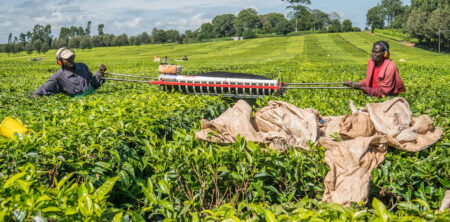Coffee production in South America is on a sharp increase and the resulting market flood is severely hurting East African coffee growers.
As supply increases, the market price is steadily falling. For trading blocs like the East African Community (EAC) where coffee is traditionally among the leading export commodities, the lower market prices spell a gloomy period up ahead.
In fact, for most of the East African countries, coffee accounts for 76 percent of the value of all agricultural exports put together. So losing the coffee market is a severe blow to economic development in East Africa and across the continent too.
Sector pundits say South America is using improved hybrids that are growing fast, producing better yields and they also have better after harvest storage and transportation facilities which are important to maintain the quality of the grain.
For example, statistics show that Brazil is now the world’s leading coffee producer with an annual output of close to 61.7 million bags. Well, if you consider the fact that in 2018 the total amount of coffee that entered the market was 170.94 million bags, this means that Brazil alone is producing almost half of all the coffee that enters the world market.
Next in line is Vietnam, which is not even traditionally a coffee producer yet in 2018 it clocked an impressive supply of some 31.1 million bags of coffee. With that high out put Vietnam is effectively boxing out Africa from the world market map.
Things are quiet gloomy for Africa’s coffee industry considering that even Colombia which produces 13.8 million bags on average, is actually producing almost double what East Africa’s top producer is currently able to bring to the market. Ethiopia is Africa’s top most coffee producer and it produces only 7.7 million bags.
Eat Africa’s production is lagging at the bottom of the barrel. After Ethiopia, it is Uganda that follows producing some 4.7 million bags of coffee. After which there is another drastic drop of production before the runners up, which is Tanzania that is producing a mere 1.1 million bags.
These figures are to small to meet global demands and across East Africa the output just gets worse. Kenya is the next runners up and it produces only 890,000 bags followed by Rwanda and Burundi each producing 268,000 and 178,000 respectively.
Luckily for East Africa, it has a solid market demand for its coffee, but how long it will be able to hold on to that market remains to be seen. At the moment Germany is East Africa’s largest coffee buyer.
Germany alone buys up to 16.5 percent of East Africa’s coffee beans and then comes Italy which procures at least 12 per cent of all of East Africa’s coffee.
None the less, East Africa is doing its best to squeeze more yield out of its coffee farms. In 2018, Uganda, the region’s leading coffee producer, increased production by 36 per cent, that is more than double the output of Rwanda and Ethiopia combined (17.6 and 16.3 percent, respectively).
Fighting to stay relevant
If East Africa is to remain relevant the coffee industry, it has to increase production, and not only that, it also has to improve the quality of its out put. However, to do this calls for reinvesting in the sector.
Considering that most coffee is grown by peasants, then each of East Africa’s governments must invest in improving the farming conditions of these small scale farmers. This means increasing access to inputs and modern farming techniques.
This is where the task lays, modern techniques. Most of the East Africa farmers are using traditional farming methods, growing the same varieties and strands that they have for decades.
Their South America competitors have adopted modern farming methods and are goring fast maturing, high yielding hybrids. Couple this with the lack of transportation infrastructure to move the coffee from rural interiors to the coast for export, East African coffee grows have to deal with storage task.
After harvest losses have huge impact on the Eat African coffee industry because the farmer usually lacks the necessary storage facilities to keep the coffee in the global market standards. Most of the coffee loses quality after harvest due to poor storage facilities. Poor quality means poor prizes.
Local media quotes Executive Director at African Fine Coffees Association (Afca), Mr. Samuel Kamau who underscored the need to improve the quality of the output that Africa brings to the market.
“…to stay relevant, then we have to produce good quality coffee that can compete with products from other countries.”
With a production capacity of 18 million bags of coffee every year that is exclusive for export, Africa cannot afford to lose its place in the world’s coffee market. However, it will require political will power to do so.
Improving coffee output cannot be left for the peasant farmer alone, it will need public private partnership to get the right hybrids, pesticides,, storage and transportation infrastructure etc.
https://theexchange.africa/countries/why-east-african-coffee-is-in-danger-of-extinction/











